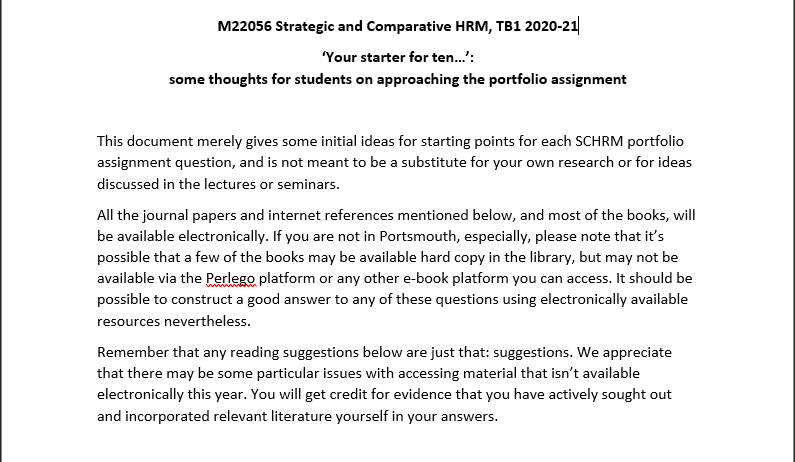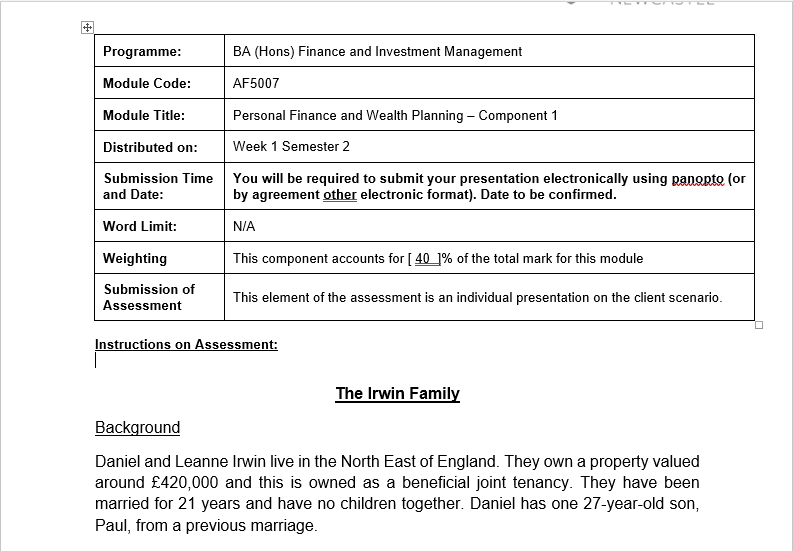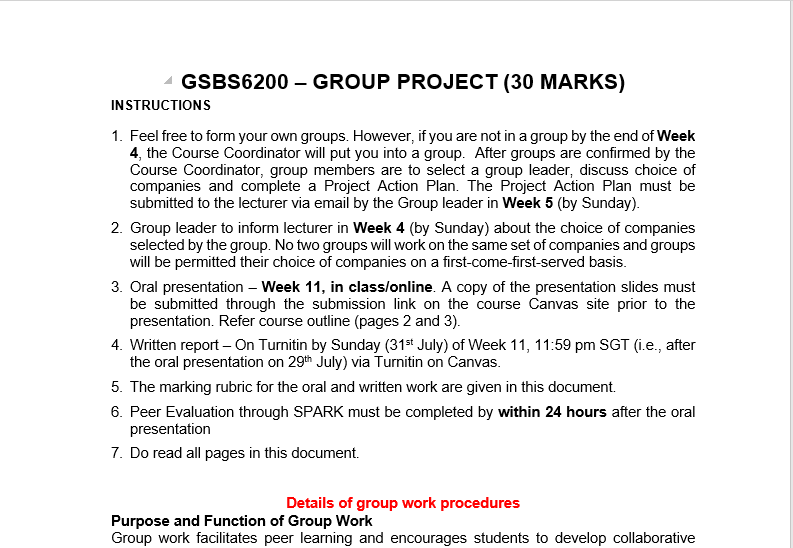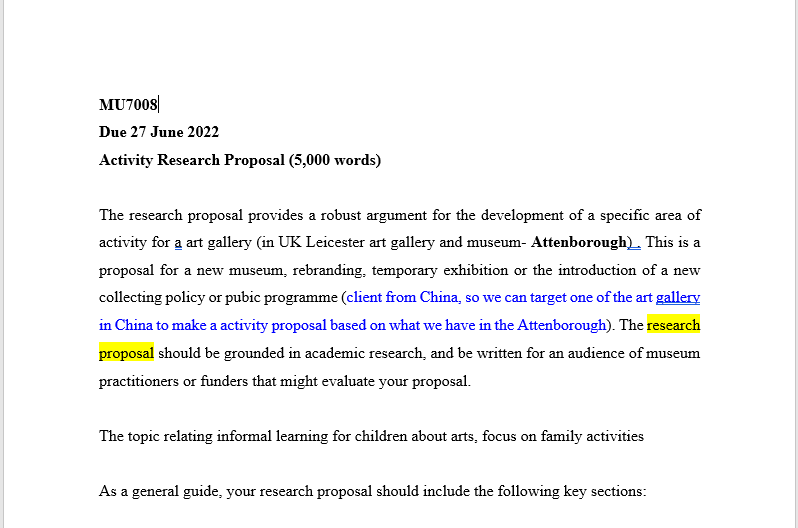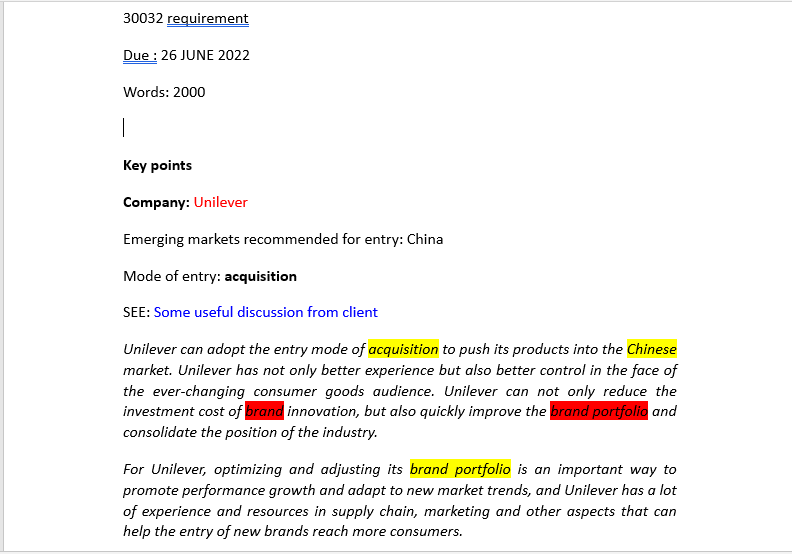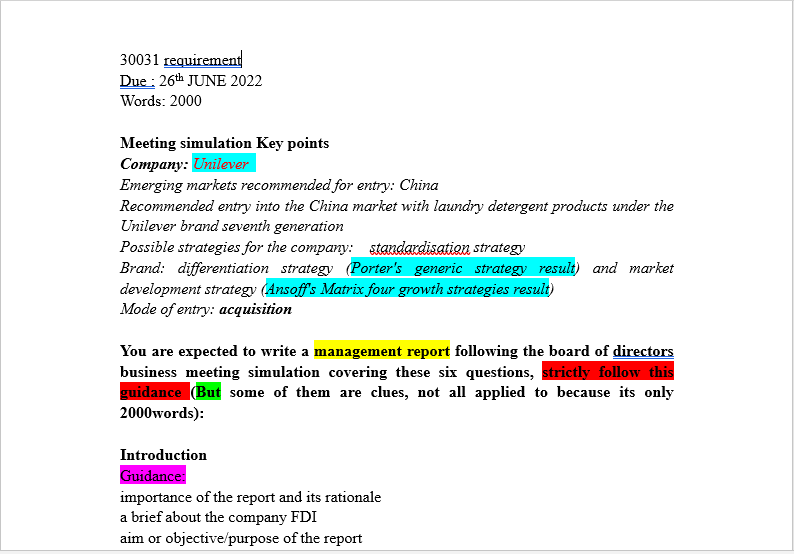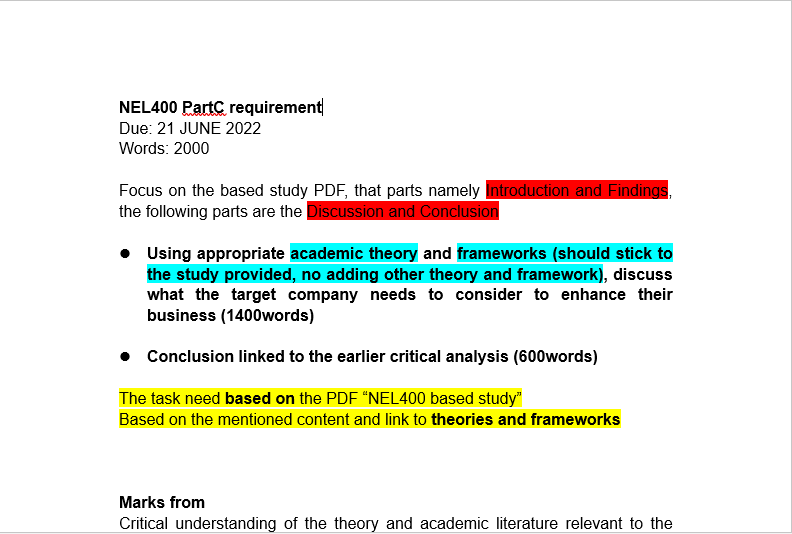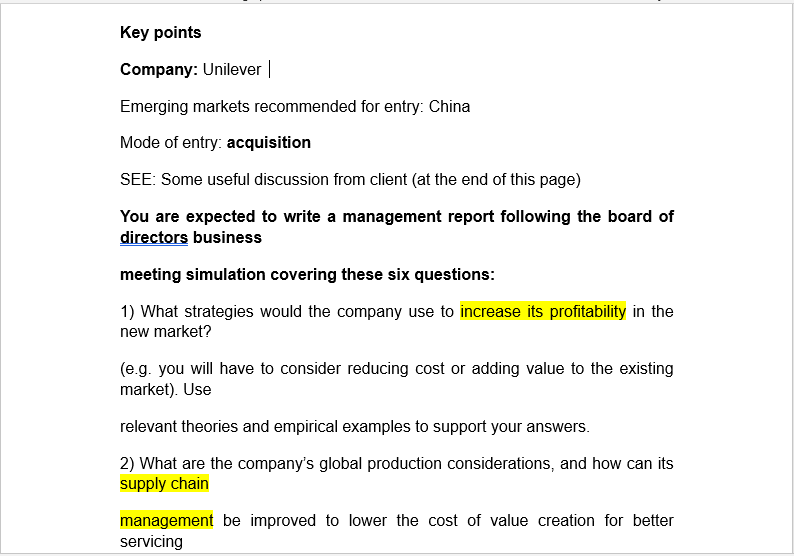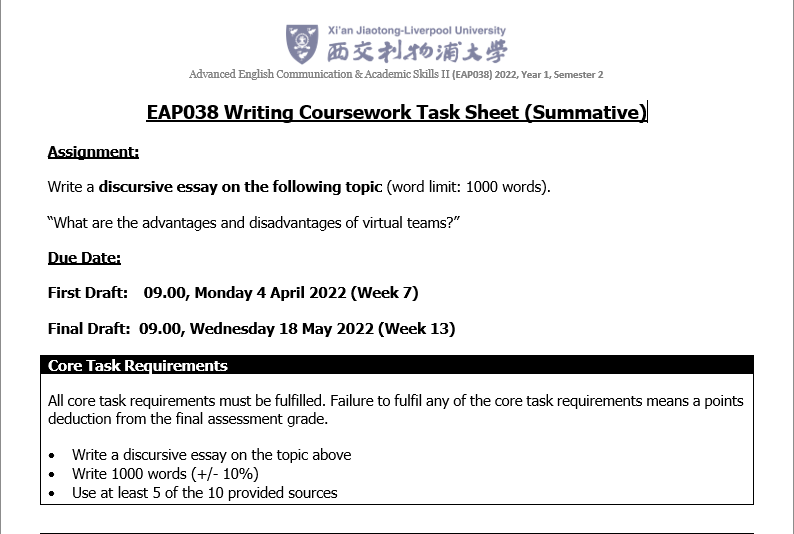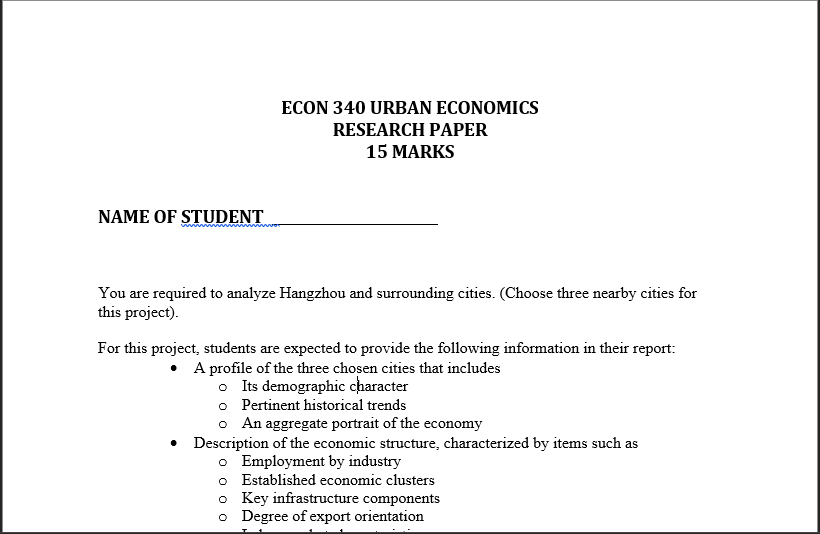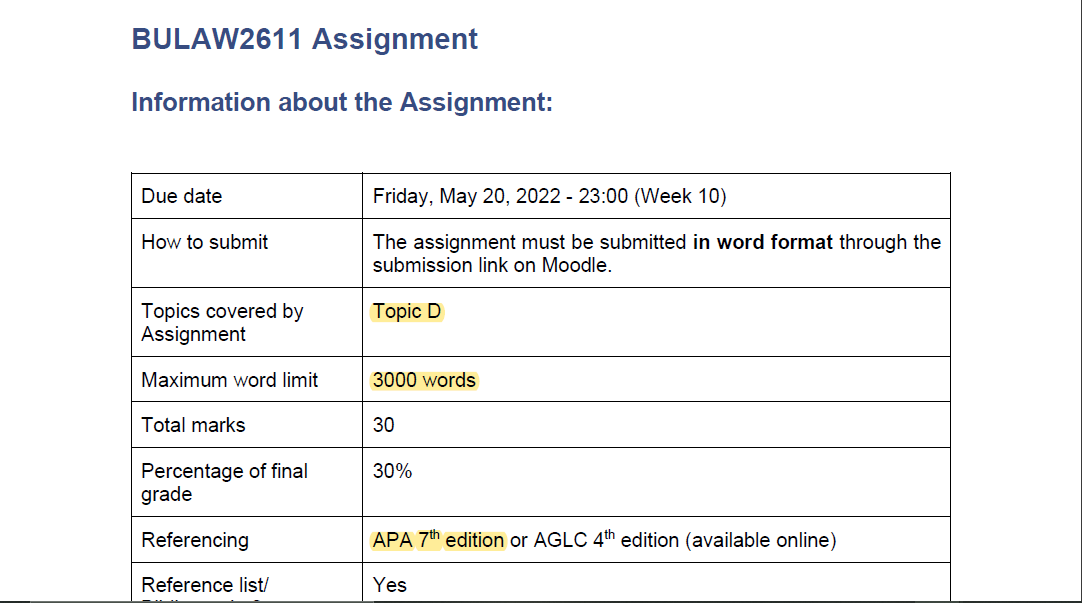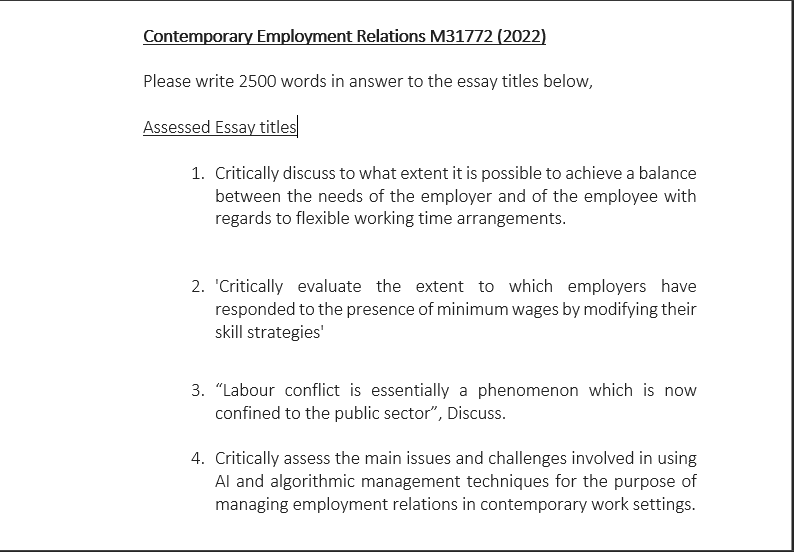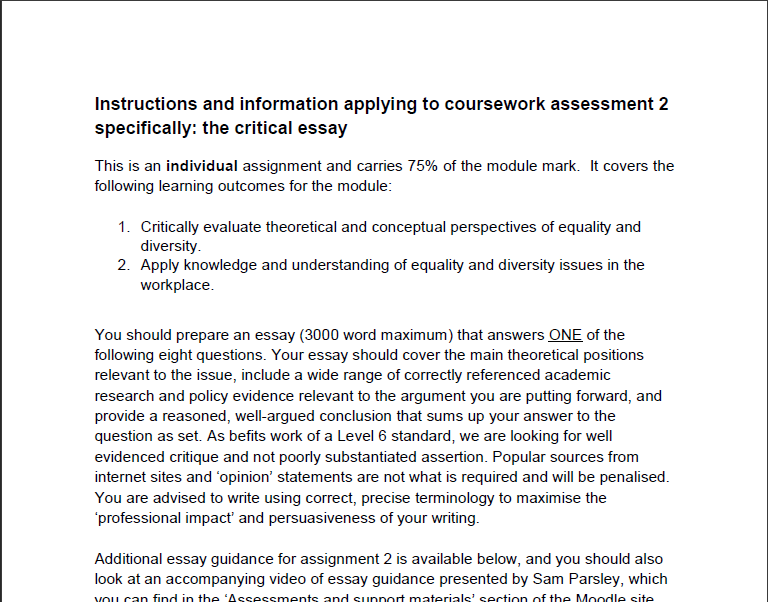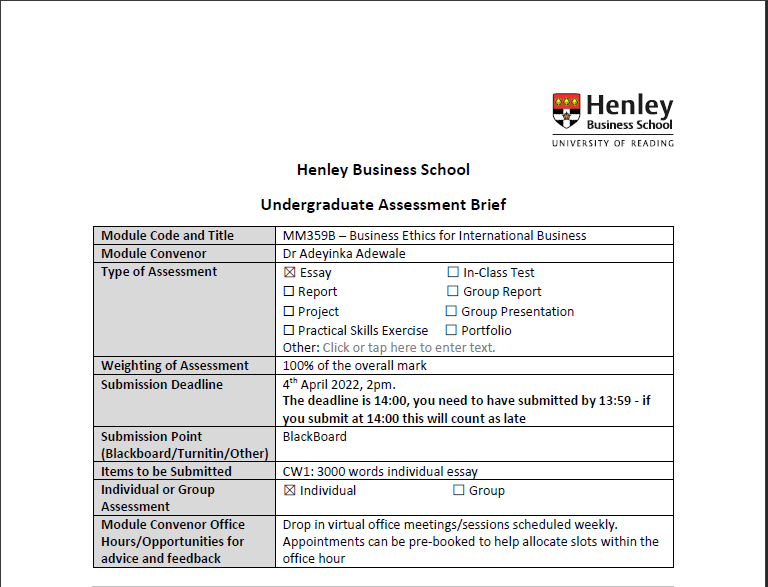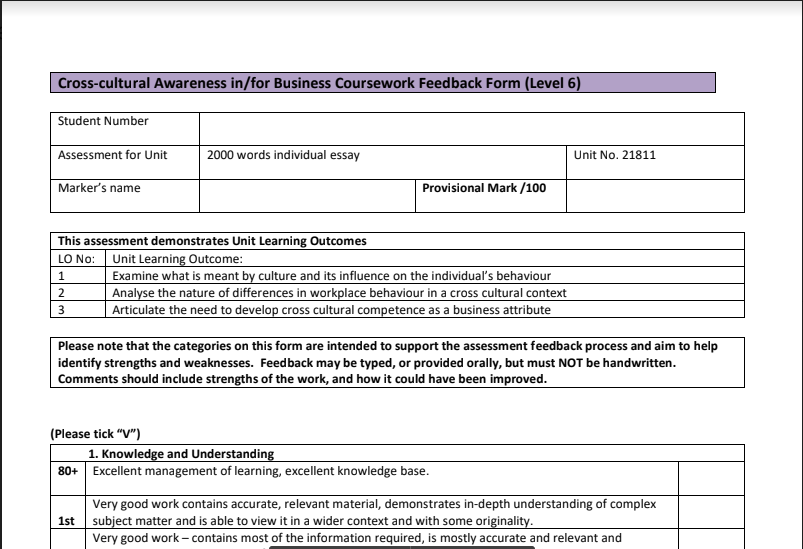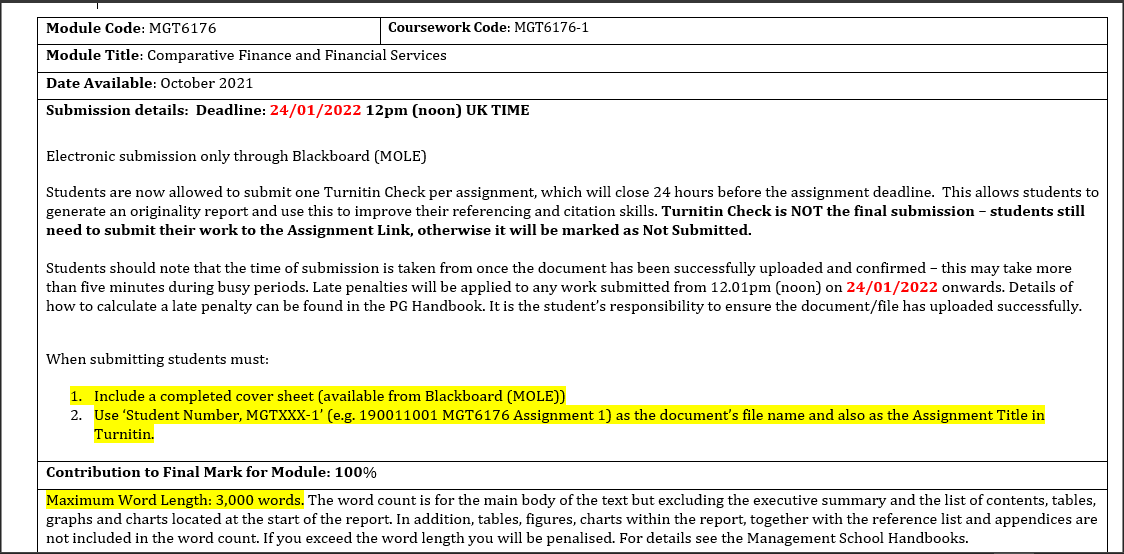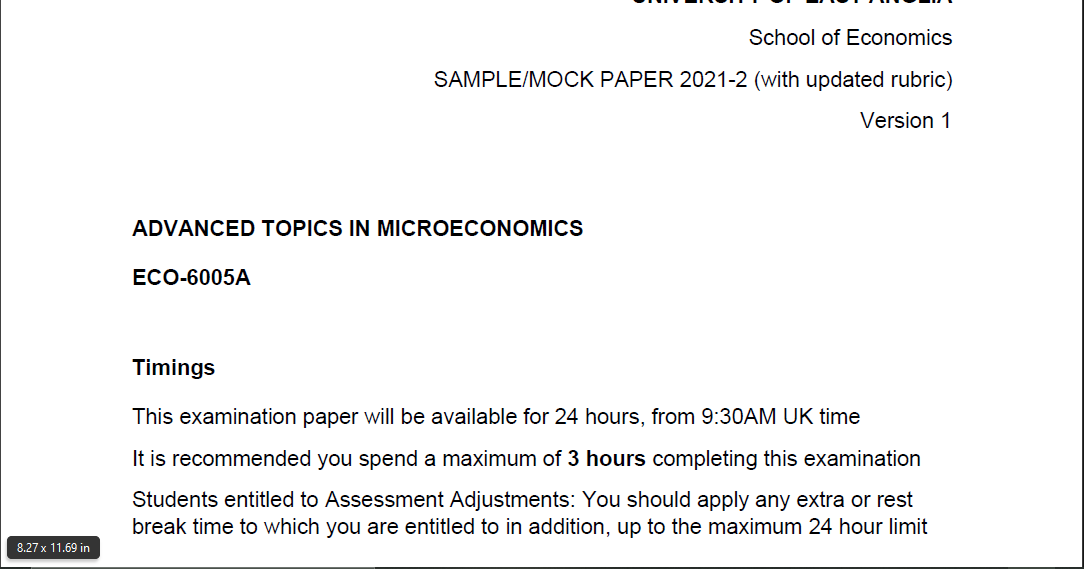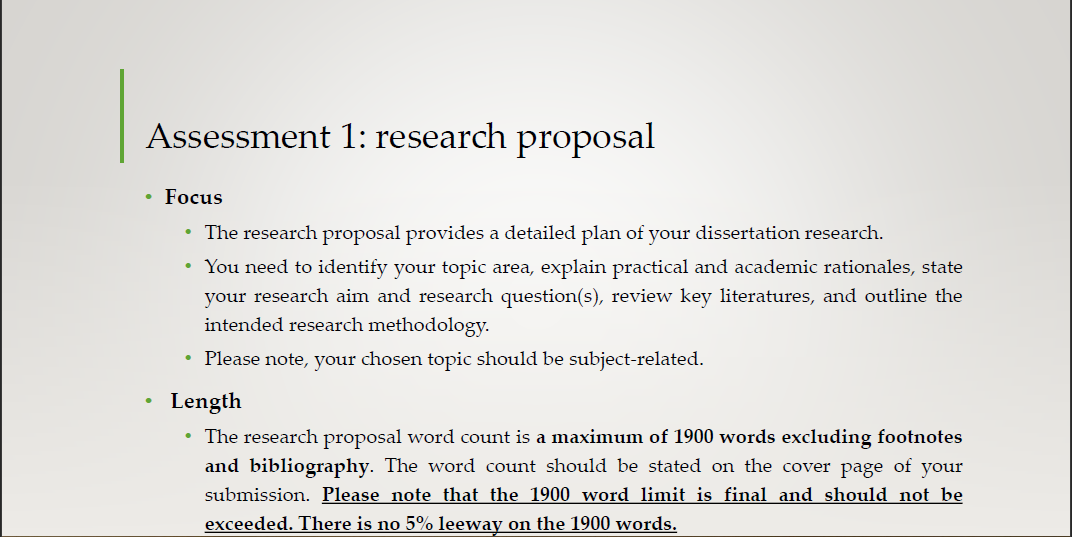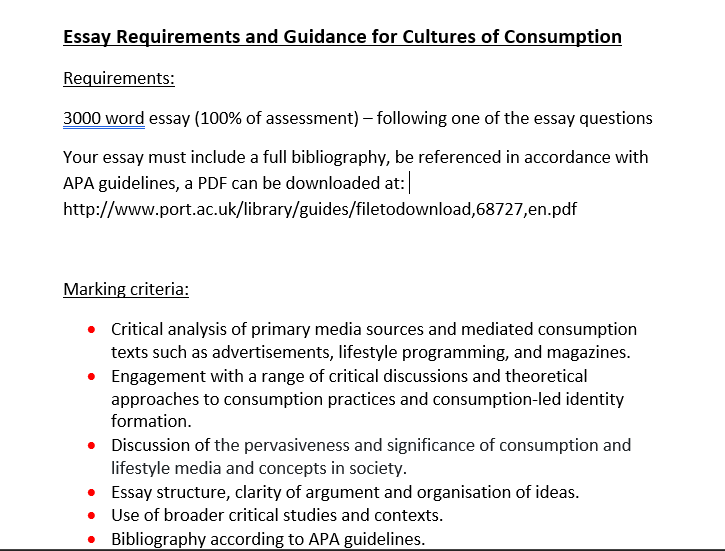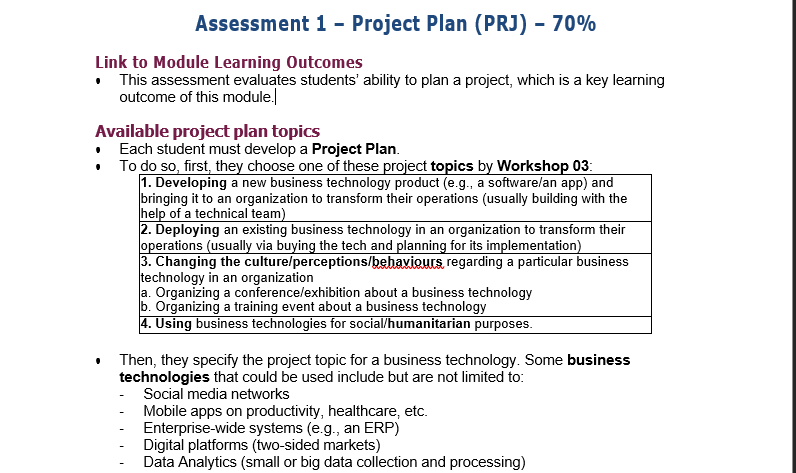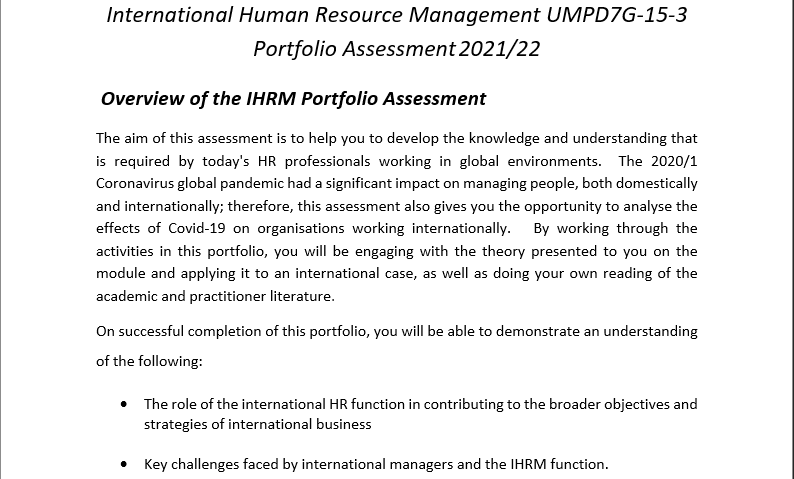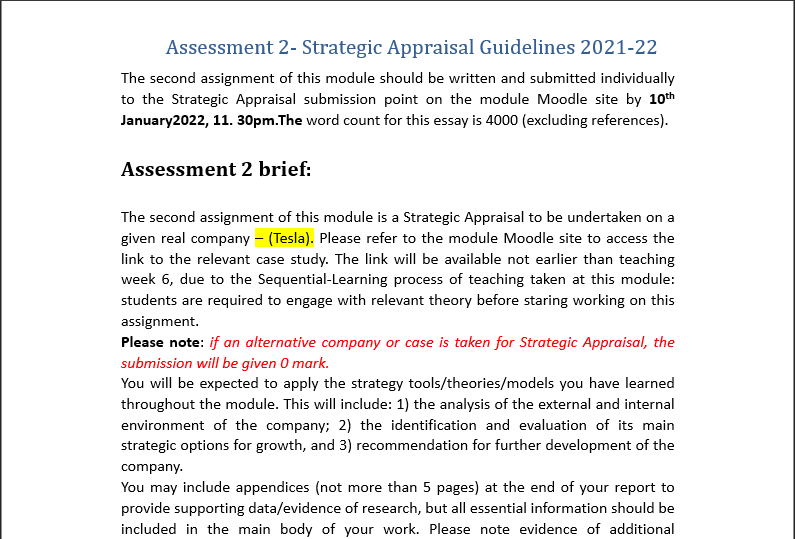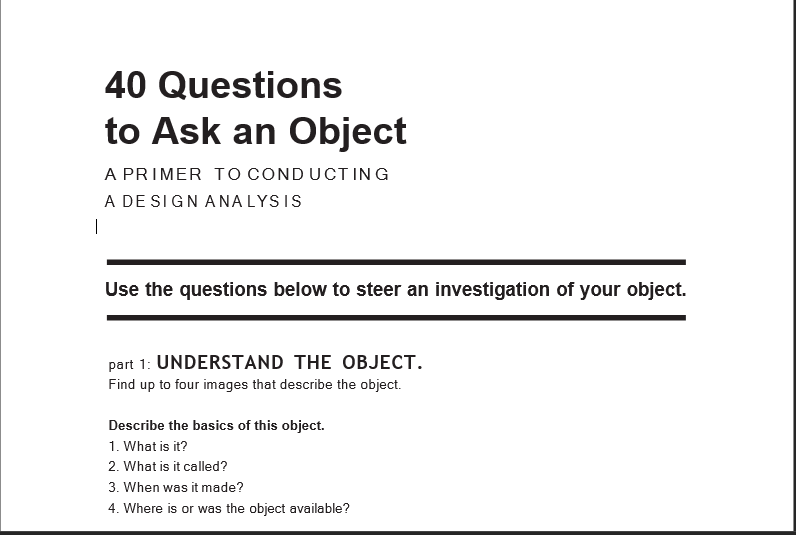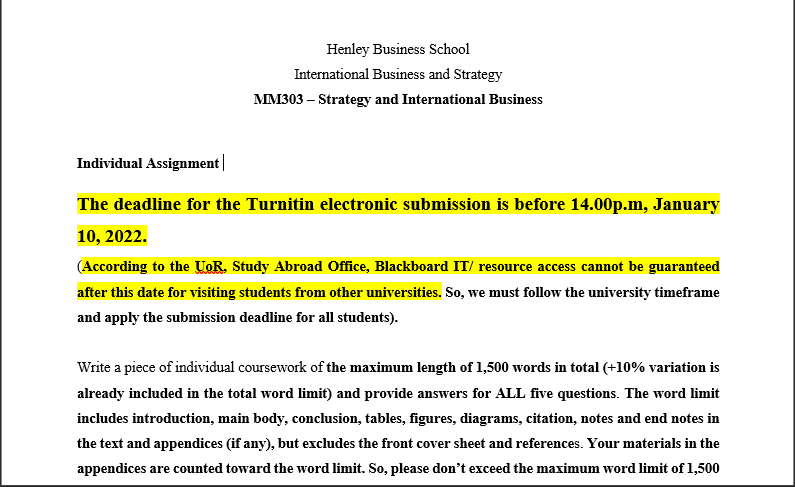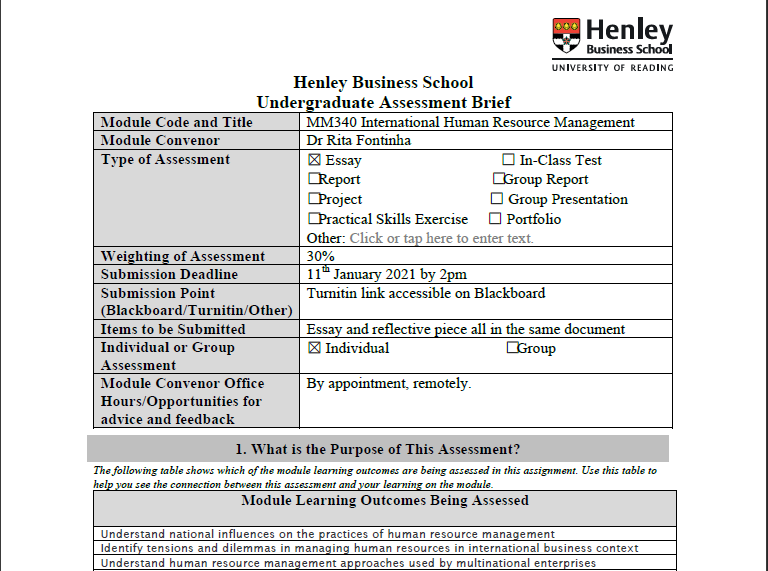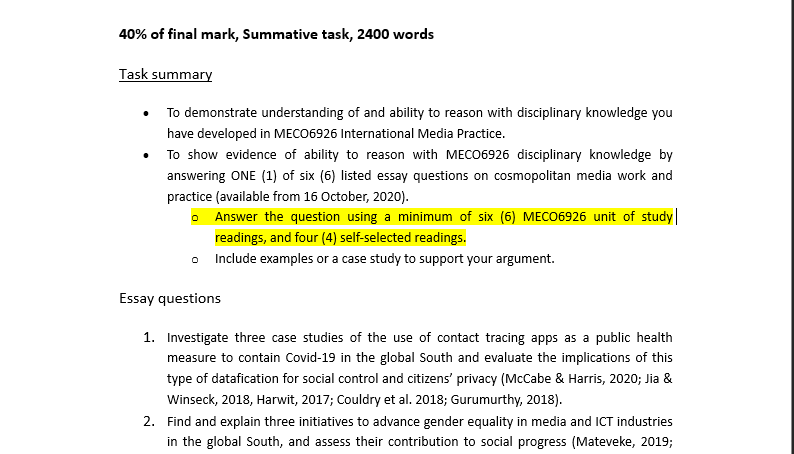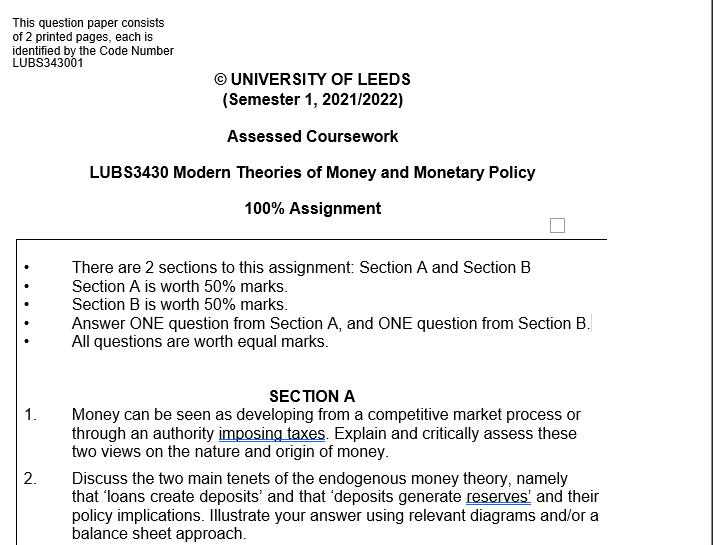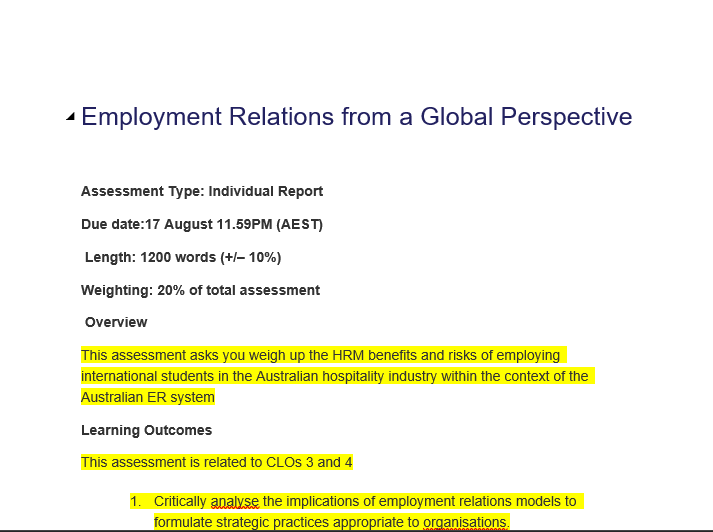M22056
Strategic and Comparative Human Resource Management
FHEQ Level 6
ASSESSMENT SCHEDULE 2021-22
v1, 20.9.21.
M22056 Strategic and Comparative HRM, TB1 2020-21
‘Your starter for ten…’:
some thoughts for students on approaching the portfolio assignment
This document merely gives some initial ideas for starting points for each SCHRM portfolio assignment question, and is not meant to be a substitute for your own research or for ideas discussed in the lectures or seminars.
All the journal papers and internet references mentioned below, and most of the books, will be available electronically. If you are not in Portsmouth, especially, please note that it’s possible that a few of the books may be available hard copy in the library, but may not be available via the Perlego platform or any other e-book platform you can access. It should be possible to construct a good answer to any of these questions using electronically available resources nevertheless.
Remember that any reading suggestions below are just that: suggestions. We appreciate that there may be some particular issues with accessing material that isn’t available electronically this year. You will get credit for evidence that you have actively sought out and incorporated relevant literature yourself in your answers.
Part 1: Indicative references to get you started on Portfolio question 1
Q1 of 4: To what extent does the HR function in organisations have a major role in managing commitment and performance?
See chapters and sections in the various texts on HRM and performance and employee commitment / engagement as a starting point; also several of the references given in relation to lectures 4 and 5 and the additional material on Moodle. References from John Purcell and his various co-authors are very relevant to addressing this question. For more practitioner-focused examples / cases, you may find some useful material on the websites of the Chartered Institute of Personnel and Development, Engage for Success, the Involvement and Participation Association, and the Advisory, Conciliation and Arbitration Service. The official so-called MacLeod Report remains important (Macleod and Clarke reference below.)
CIPD (ed.) (2014) The Future of Engagement, London, CIPD, https://www.cipd.co.uk/Images/the-future-of-engagement_2014-thought-piece-collection_tcm18-10758.pdf
Guest, D. (2011) Human resource management and performance: still searching for some answers, Human Resource Management Journal, 21, 1, 3-13.
MacLeod, D. and Clarke, N. (2009) Engaging for Success: Enhancing Performance through Employee Engagement, London, Department for Business, Innovation and Skills. (Available online.)
Purcell, J. (2010) Building Employee Engagement, ACAS Policy Discussion Papers, London, ACAS. (Available on ACAS website: www.acas.org.uk)
Sanders, D. (2012) Placing Trust in Employee Engagement, Employment Relations Comment, November, London, ACAS. (Available on ACAS website: www.acas.org.uk)
Truss, C., Delbridge, R., Alfes, K., Shantz, A. and Soane, E. (2014) Employee Engagement in Theory and Practice, Abingdon, Routledge, esp. chs. 5, 6, 12, 13.
Part 2: Indicative references to get you started on Portfolio question 2
Q2 of 4: How tenable is it to suggest that human resource management is converging on a Western model?
This is basically a question about the conflicting pressures of convergence and continued diversity in comparative human resource management and employment relations, and especially the extent to which Western HRM models are transferable to non-Western countries. Some - brief - non-Western examples would be relevant to incorporate. Some of the material discussed in lecture 3 on the transfer of ‘best practice’ models is also relevant. The Edwards and Rees textbook, in particular, and most of the other international HRM textbooks are generally useful here on convergence and diversity in HRM and national HR systems. See also the following, among a wide range of possible literature. The potential impact of multinational corporations (MNCs) is important here, and the article by Chiang et al is worth a particular mention as an article that summarises well a lot of the existing research on MNCs.
Baccaro, L. and Howell, C. (2017). Trajectories of Neoliberal Transformation. European Industrial Relations since the 1970s, Cambridge: Cambridge University Press.
Barry, M. and Wilkinson, A. (2011) Research Handbook of Comparative Employment Relations, Cheltenham: Edward Elgar (chapter one)
Budhwar, P. and Varma, A. (2011) Emerging HR management trends in India and the way forward, Organizational Dynamics, 40, 4, 317-325.
Chiang, F., Lemànski, M. and Birtch, T. (2017) The transfer and diffusion of HRM practices within MNCs: lessons learned and future research directions, International Journal of Human Resource Management, 28, 1, 234-258.
Chen, M.-J. and Miller, D. (2010) West meets East: towards an ambicultural approach to management, Academy of Management Perspectives, 24, 4, 17-24.
Frege, C. and Kelly, J. eds (2020) Comparative Employment Relations in the Global Economy, 2nd ed., Abingdon: Taylor and Francis (chapters one and two).
Farnham, D. (2015) The Changing Faces of Employment Relations: Global, Comparative and Theoretical Perspectives, London: Palgrave Macmillan (pp.15-26).
Hall, P. and Soskice, D. (2001) Varieties of Capitalism: the Institutional Foundations of Comparative Advantage, Oxford, Oxford University Press.
Katz, H. and Darbishire, O. (2000): Converging Divergences: Worldwide Changes in Employment Systems. Ithaca NY: Cornell University Press.
Wailes, N., Wright, C., Bamber, G. and Lansbury, R. (2016) ‘An internationally comparative approach to employment relations’, in G. Bamber, R. Lansbury and N. Wailes (eds), International and Comparative Employment Relations: National Regulation, Global Changes, London: Sage, 1-19.
Part 3: Indicative references to get you started on Portfolio question 3
Q3 of 4: How can multinational firms best address demands for minimum international labour standards within their supply chains?
The reading for the teaching week 9 is your main reference point for this write-up, although some of the material from teaching weeks 7 and 8 on why multinational companies (MNCs) might present a problem for labour standards will also be relevant. From the list for teaching week 9, some of the international employment relations and HRM textbooks by more UK-based authors have chapters on this: notably Frege and Kelly (see full reference for book in list above for Q2) and Martinez-Lucio. See also Williams et al.’s text Globalization at Work. On voluntary codes of conduct authors such as Locke, Marginson, Royle and Voss can be particularly recommended; if you like the idea of international framework agreements, then Marginson and Voss again, and Niforou are good starting points. Remember you are being asked which you think is the best approach. You’re not being asked to do a side by side comparison, although you should be able to justify why you think your preferred approach is better than others.
Part 4: Indicative references to get you started on Portfolio question 4
Q4 of 4: What is meant by a strategic approach to HRM? Does the available evidence suggest that the HR function can exercise a strategic role?
Please note that this final question is the broadest of the four and, in many ways, it is design for you to show that you have learnt something from the module overall. Your answer should say something about the possibilities of strategic HRM in multinational firms specifically as well as those that operate just on a national level. So the question could cover reading relevant to the first part of the teaching block as well as the final two weeks. Don’t try to cover everything, but do give at least a bit of consideration in your answer to what you think might be the additional promise and problems of implementing strategic HRM in transnational firms.
Strategic HRM – from the textbooks see e.g. Farnham, ch. 5, Gilmore and Williams, ch. 2, Rees and Smith, Part 1, Syed and Kramar, ch. 2, Bailey et al, esp. chs. 4 and 5, Vanderstraeten, esp. Part 3.
Strategic HRM – more general example sources
Aryee, s. et al (2008) Strategic Human Resource Management, London, CIPD, esp. ch. 1.
Bailey, C. et al (2018) Strategic Human Resource Management, 2nd ed., Oxford, Oxford University Press.
Schuler, R. and Jackson, S. (2007) Strategic Human Resource Management,, 2/e, Oxford, Blackwell.
Storey, J. et al (2009) The Routledge Companion to Strategic Human Resource Management, Abingdon, Routledge.
Ulrich, D. (2013) Human Resource Champions, Cambridge, MA, Harvard Business Press.
Wilton, N. (2019) An Introduction to Human Resource Management, 4/e, London, Sage, ch. 3.
Specifically strategic international HRM (SIHRM) sources
The reading list for teaching week 11 seminar is the main port of call for the general issue about the promise and limits of SIHRM; the reading list for teaching week 10 will be useful if you want to use expatriate assignments as one possible example of attempts at strategic integration. Most of the international HRM texts have chapters on expatriation, and Tarique et al.’s International HRM text is better than most on this topic; for journal articles on this, International Journal of Human Resource Management is probably the best place to look first. There are other examples of strategic integration apart from expatriation, e.g. talent management or diversity management, for which see some of the relevant sources in the teaching week 11 list. On the general issue of SIHRM you can use the teaching week 11 key references for initial orientation. Sparrow, Brewster and Chung can be particularly recommended for SIHRM, of the textbooks, the Tarique et al text and Reiche et al (see below) are useful starting points.
Reiche, S. et al (2019) International Human Resource Management, 5th ed., London, Sage.
Peter Scott
M22056 SCHRM module coordinator
Nov 2020
UNIVERSITY OF PORTSMOUTH
Organisation Studies & HRM Subject Group
Faculty of Business and Law
Module coordinator
Peter Scott, [email protected] *
* If there is any change to who is coordinating the module during the course of the academic year, you will be informed.
Assessment
General information about assessment and assessment submission on this module
All assessment tasks must be completed by students individually.
All coursework submission on this module is electronically via the Moodle assignment dropbox on the module’s Moodle site, by no later than 23:55 on the relevant deadline day. Do not leave starting submission until the very last minute. The system can get much slower as it gets toward deadline time, and you risk not being able to complete submission before the cut-off time. This has already happened to some students on the module in previous years, so this warning has been included for good reason. Comprehensive guidance on online electronic submission procedures can be found in the assignment submission dropbox on the module Moodle site.
You should run your work through Turnitin before submission and include a Turnitin percentage similarity score with your work.
The assessment consists of a portfolio that addresses all module learning outcomes. You must keep an electronic copy of the submitted version of all assessed work, as required by the university’s Examination and Assessment Regulations, but you do not need to print out copies for submission purposes.
Advice on electronic submission is available in the assignment dropbox on the module Moodle site. From bitter experience, can we please stress here that all work submitted electronically should:
- have a filename that includes your HEMIS number (not including your name) and preferably briefly says what assignment it is;
- include your HEMIS number and consecutive page numbering on each page;
- include an accurate word count for each item that makes up the portfolio (see below for what to include in, and to exclude from this);
- not include your name anywhere in the file.
You may get penalised if you fail to do any of the above, and especially if you include anything that invalidates the anonymity of your assignment.
Specific information on the coursework assessments for this module
The single item of assessment for this module is one portfolio with a word limit of 3,900 words in total, comprised of four separate items, but to be submitted electronically as one file: much preferably, as a Microsoft Word file, please. You are required to answer all of the questions. Equal marks and word limit of 975 words apply to each item, each of which should be written up as a ‘mini-essay’. So each answer should have its own reference list, rather than one combined reference list at the end of the portfolio. Please start each answer on a fresh page. Each item is worth 25% of the overall portfolio and module mark. If one or more items is missing from the final portfolio, your overall mark will be reduced proportionately. Together, the questions broadly cover the whole of the SCHRM syllabus.
Overall, your portfolio will be assessed on the extent to which your portfolio, taken as a whole, meets the three learning outcomes of the module:
1. Analyse and compare different approaches to the strategic dimensions of human resource management and the problems and prospects of applying these in practice.
2. Evaluate the dimensions of the human resource role and the human resource function in different types of organisation.
3. Analyse critically the international and ethical dimensions of human resource management.
In addition, the portfolio will be assessed according to its quality as a piece of written English coursework, aligned to the guidelines given in the University’s generic assessment criteria for FHEQ level 6, which incorporates criteria such as appropriate reference to a range of relevant literature and conformity to word limits.
University generic grading criteria for FHEQ level 6 final year undergraduate work
80+
As below plus:
- Outstanding work - contains accurate, relevant material, demonstrates understanding of complex subject matter & is able to view it in a wider context. Shows originality & confidence in analysing and criticising assumptions, is aware of the limits of knowledge. Likely to add new insights to the topic & approaches the quality of published material
- Evidence of extensive research, uses & presents references effectively
Outstanding quality in terms of organisation, structure, use & flow of language, grammar, spelling, format, presentation, diagrams, tables etc
70-79
As below plus:
- Outstanding work - contains accurate, relevant material, demonstrates understanding of complex subject matter & is able to view it in a wider context. Shows originality & confidence in analysing and criticising assumptions, is aware of the limits of knowledge
- Evidence of extensive research, uses & presents references effectively
Excellent in terms of organisation, structure, use & flow of language, grammar, spelling, format, presentation, diagrams, tables etc
60-69
As below plus:
- Very good work - contains most of the information required, is accurate & relevant & demonstrates understanding of the subject matter & attempts to view it in a wider context. Shows some originality of thought with good critique & analysis assumptions, is aware of the limits of knowledge
- Well researched, good use & presentation of references
Very good in terms of organisation, structure, use & flow of language, grammar, spelling, format, presentation, diagrams, tables etc
50-59
As below plus:
- Work that attempts to address the topic with some understanding & analysis, key aspects of the subject matter covered
- Research extends to primary sources. Appropriately cited and presented references
- Satisfactory presentation with respect to presentation, organisation, language, grammar, spelling, format, presentation, diagrams, tables etc
The majority of students might normally be expected to fall within this range.
40-49
- Adequate work which attempts to address the topic with limited understanding & analysis
- Some research using texts, Internet & key reference sources with reference citation and presentation according to convention
An attempt to follow directions regarding organisation, structure, use & flow of language, grammar, spelling, format, diagrams, tables etc
30-39
FAIL Anything which is inadequate in most or all of the following: length, content, structure, analysis, expression, argument, relevance, research and presentation. Work in this range attempts to address the question/problem but is substantially incomplete and deficient. Serious problems with a number of aspects of language use are often found in work in this range
<29
FAIL No serious attempt to address the question or problem, and/or manifests a serious misunderstanding of the requirements of the assignment. Acutely deficient in all aspects.
Portfolio questions
You need to attempt all four questions. Each question is worth 25% of the overall assessment and module mark.
Q1 of 4: To what extent does the HR function in organisations have a major role in managing commitment and performance? (Particularly relevant teaching weeks for answering this question include teaching weeks 4-5.)
Q2 of 4: How tenable is it to suggest that human resource management is converging on a Western model? (Particularly relevant teaching weeks for answering this question include 6-8, 11.)
Q3 of 4: How can multinational firms best address demands for minimum international labour standards within their supply chains? (Particularly relevant teaching weeks for answering this question include teaching weeks 8-9.)
Q4 of 4: What is meant by a strategic approach to HRM? Does the available evidence suggest that the HR function can exercise a strategic role? (Particularly relevant teaching weeks for answering this question include teaching weeks 2-3, 10-11)
The assessment deadline for electronic submission via Moodle assignment on the module Moodle site is 23:55 hours GMT, Monday January 31st 2022. The deadline for late submissions is 23:55 hours GMT, Monday February 14th 2022. Anything submitted after this will not be marked.
Opportunity for formative feedback to students on the portfolio assessment
Any student that wishes to have some intermediate written formative feedback on their portfolio is invited to submit direct to their seminar tutor, by no later than Friday 3rd December (the end of teaching week 7), a draft of one or more of the portfolio items. Submission should be by email attachment.
Any such draft submitted for this should be as near as possible to what you would regard as a complete draft, i.e. with introduction, body of text and conclusion, and with full referencing in text and bibliography. We will not give feedback on some general vague ideas about what you might think is relevant or what you might put in an answer, initial bullet points with no referencing, etc., etc.
The following conditions apply to this offer of formative feedback, which we would encourage you to take up.
- Students are not required to take this offer up if they do not wish to, but should not expect that the same offer will remain open after the deadline stated. Depending on how many students take up this offer of formative feedback, commenting on your draft may be redirected to another tutor on the module.
- The target to give individual feedback for those that do choose to take up this offer will be the last week of the Autumn Term (teaching week 8), although we may have to vary this if a lot of students take up the offer.
- In order to preserve the integrity of the eventual marking process, formative feedback will be generic. It will concentrate on general ways in which your work could be improved, within the guidelines of the ‘Commenting on draft student coursework’ section below, and will not give any indication of possible mark or grade, or whether the work can be regarded as passable or not.
Arrangements for managing assessments
Marks for each assessment will be made available to individual students as soon as the assessment has been marked, verified, and marks processed. We anticipate that this should normally happen within twenty working days of the original submission deadline. Arrangements for being able to view your marked work, with markers’ comments on, will be notified to you in due course. The relevant ‘plus 20 working days’ date for the current academic year is Monday 28th February, 2022. Please do not contact tutors to question marks before viewing your marked work and reading the feedback on it.
Although we work to the University’s target of providing feedback within 20 working days of the submission date, the inputting of marks into the system may take a little longer in some cases, especially at busy times of year. ‘Working days’ exclude weekends and public holidays. If significant delays are expected, we will of course keep you informed. Please note that the 20 working day target does not apply to any assignments submitted after the submission date.
Formatting of coursework assignments
All coursework should be word processed, in an easy to read font such as Calibri, Arial or Times New Roman. Use a font size no smaller than 11 point and no larger than 14 point: this document is written in Arial 12 point, for example. Allow a reasonable amount of space within and between paragraphs, preferably using 1.5 line spacing. Above all, allow a decent size page margin all round, so that we have enough space to write comments if we want to. Each page must include a header with your student number and a header or footer with consecutive page numbering. Avoid the use of bullet points in the text of your answers unless absolutely necessary. Each item in the portfolio should be written as a self-contained mini-essay with its own reference list.
Referencing protocols and style in your assessed coursework
Your references should be in the APA (7th ed.) style. See below for guidance on this referencing.
- Returning student video - differences in APA 7th from APA 6th (6-ish mins) https://port.cloud.panopto.eu/Panopto/Pages/Viewer.aspx?id=0abc0c33-84fe-4e93-a0bf-ac2b00a72dff
- Business Academic Integrity tutorials - why and how to reference - fully updated to APA 7th with business examples: https://moodle.port.ac.uk/course/view.php?id=6467
- General Library guidance - For APA 7th (business modules) or OSCOLA (law modules) referencing examples, please see https://library.port.ac.uk/referencing
You should of course avoid any suspicion of plagiarism or ‘poor scholarship’. If you have any concerns about this then please consult a tutor. Avoid using sources of dubious reliability such as Wikipedia for information. Use of dubious, poor quality or irrelevant internet sources in coursework is likely to be penalised. Similarly, don’t do what some students have done in the past to try to convince us of their academic credentials by including loads of citations to academic journal papers whose subject matter is completely irrelevant to the point being made. We will spot it if you do this, and it won’t end well.
Word limits in assessed coursework: what counts and what doesn’t
For the avoidance of doubt, the stated maximum word limits provided for particular items of assessment are supposed to be just that: the maximum. There is no unofficial ‘plus or minus 10% leeway’. The word count includes everything from the start of the text of each answer to the end of the text that precedes the beginning of your APA reference list, although it excludes any footnotes you have used. Use the word count facility in Word to determine your word count for this block of text. Your reference lists do not count as part of the word count, but in-text citations inevitably do. Please do not use footnotes any more than is absolutely necessary. Certainly, do not use excessive footnoting as an ingenious device to attempt to get round the word limits, as we will penalise this if we suspect it. Please provide accurate, actual word counts for each of the items required for the portfolio. It’s easiest to put this at the beginning or end of each write-up and, no, the word count statement should not itself be counted as part of your word count. Your actual word count is what you should put on your assignment when you submit it electronically, not the intended maximum, because this is misleading. It is an assessment offence to state an inaccurate or misleading word count, or not to include one at all, and we will penalise it.
Commenting on draft student coursework
The purpose of assessment is for tutors to be able to evaluate your own skills and your knowledge and understanding of the module’s content, as evidenced by the work that you hand in. Tutors are here to help you in your studies. However, a balance must be struck so that everyone can be certain that what is being marked remains clearly your own work (please also see the separate section on this).
What help you can expect tutors to provide
Tutors can answer general queries about how to approach an assignment, interpretation of questions, relevant content, matters of style and English usage, referencing, appropriate reading, etc. Tutors can give guidance about what measures students might take to generally improve work.
Order to get the answer to this

